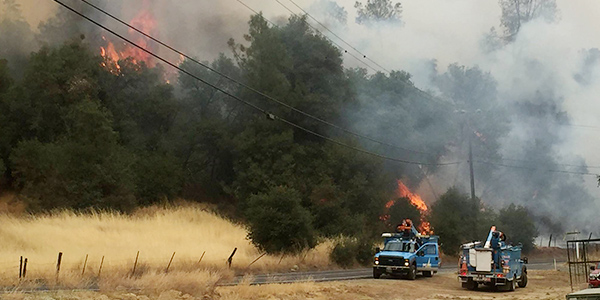By Hudson Sangree
PG&E Corp. officials told California regulators last week that its public safety power shutoffs (PSPS) could continue for another decade, and that it was making plans to turn off electricity to all its 5.4 million customers should circumstances warrant it.
“The likelihood of an event of this scale occurring is extremely low; however, in an abundance of caution, by next wildfire season, PG&E is looking into additional hardware and capacity to accommodate an outage at this scale,” the utility said in its written response to the California Public Utilities Commission’s request for information about its shutoff policies.
The CPUC called an emergency meeting Friday at which Bill Johnson, the company’s recently installed CEO, and Nora Mead Brownell, its new chair of its board of directors, addressed commissioners.
Johnson, former head of the Tennessee Valley Authority, defended PG&E’s decision to black out 738,000 customers, or about 2 million Californians, as an effective tool that prevented wildfires during dry, windy conditions from Oct. 9 to 12. The devastating North Bay fires of October 2017, for which PG&E bore most of the blame, occurred in similar circumstances, he noted. So did November’s Camp Fire, the deadliest and most destructive wildfire in state history.
“I feel my highest accountability is safety,” Johnson said.
PSPSes could continue until 2030 as the utility tries to harden its grid against trees and branches blowing into power lines, the chief executive said. The shutoffs will likely narrow, although the risk of catastrophic wildfires from climate change will increase, he said.
“I think they’ll decrease in size and scope every year, but at the same time we’re doing this, the risk is not static,” Johnson said. “It’s dynamic, and it goes up every year.”
CPUC President Marybel Batjer asked Johnson about a letter he sent Friday to Gov. Gavin Newsom suggesting a government agency, such as the CPUC or the California Department of Forestry and Fire Protection, should call for PSPS, instead of utilities, to promote public trust.
Johnson said he wasn’t trying to shirk PG&E’s responsibility. But the public is skeptical of the troubled utility’s intentions, and “public confidence in the decision [to institute a PSPS] is really important,” he said.
Johnson, Brownell Questioned
Commissioner Genevieve Shiroma asked Brownell — a former FERC commissioner, Pennsylvania regulator and president of the National Association of Regulatory Utility Commissioners — what advice she would give her and her colleagues about dealing with PG&E if she were in their place.
“As someone who has sat in our chairs and held utilities accountable, what specific advice — or specific laser-like things, if you were sitting here — [would you] be telling PG&E to effectuate in the aftermath of these PSPSes?” Shiroma asked.
Brownell said she would require PG&E to meet measurable performance goals, though she did not offer specifics.
“Thanks for the question, and I wouldn’t presume to tell you how to do your jobs,” Brownell said. “But I think the letters [exchanged] this week [between the CPUC and PG&E] and the ongoing focus on very specific outcome-based measures is very, very, very important.
“I think it’s one thing to talk platitudes. It’s another to actually measure people by the outcomes that you talked about,” she said. “And in fact, at NARUC, at FERC, even when I was a Pennsylvania state commissioner, we talked a lot about moving from that rate-based model to a business model that was more performance-based.”
Batjer repeated her assertions that PG&E had failed woefully in executing its massive power shutoffs, including by failing to prevent its website from crashing and by allowing its call center to become overwhelmed with customers demanding information. (See related story, CPUC Orders Changes to PG&E Shutoff Rules.)
“You guys failed on so many levels on fairly simple stuff,” Batjer said.
Johnson admitted as much. “Making the right decision on safety isn’t the same as executing this decision well,” he said, vowing to improve.
Commissioner Martha Guzman Aceves noted that neither Brownell nor Johnson were Californians, nor were other PG&E board members appointed earlier this year after the company, facing $30 billion in fire debts, declared bankruptcy. (See PG&E Names New CEO, Board Members.)
“Being connected to the communities that are being disconnected” is inherently valuable, Guzman Aceves said. “This seems to me like something that I would really see value in … a board that really reflected California, that reflected in terms of the communities that are impacted and certainly that reflected the demographics of California.”
She asked whether Brownell was living in the state. Brownell said she had been staying with relatives before renting an apartment.
Guzman Aceves also questioned another executive new to California — Andrew Vesey, the CEO of Pacific Gas and Electric — about whether he was familiar with two small Northern California communities affected by the outages. Vesey, whose last job was in Australia, said he wasn’t.
“Is the board demographics and [its] experience and knowledge of California” reasonable and adequate? Guzman Aceves asked.
Johnson replied, “I think it’s really important to have a board that reflects the constituency, the customer base, the state, and understands it. And I think eventually this board will get there.
“I think this board was assembled in unusual circumstances having to do with a bankruptcy and some other things,” he continued. “But as to your basic premise about how a board should look and should it be able to relate, particularly a utility board, to the utility customers, I agree with that.”







